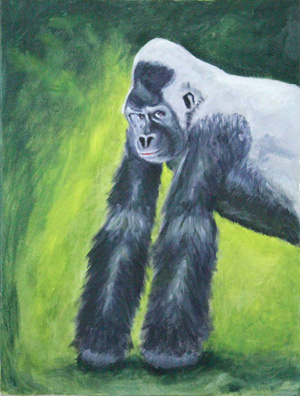Gorillia - Yet Again???!!!!!

This is probably the final rendering of what has clearly been a work in progress. You can see the preliminary studies if you click here and here.
This is a painting in oil, a surprisingly late arrival in the pantheon of artistic media. Water color and encaustic (wax) are at least thousands (if not hundreds of thousands) of years old. Egg tempera came later, possibly late antiquity and certainly by the early middle ages. A primary advantage of tempera is the medium - the yolk of an egg - is as close as the nearest hen house and requires little processing. Tempera also dries quickly (sometimes an advantage; sometimes not) and keeps its color well. But a major disadvantage is tempera becomes brittle and unless it is on a good solid support will eventually crack and flake. Most tempera paintings are on panel.
When we say oil painting was a late artistic arrival we are referring to its general adoption by artists in Europe (it was used the Middle East as early as the 7th century of our era). The oil in oil paint not petroleum but vegetable oil. Any kind will do, but usually linseed oil (from flax) and walnut have been the favorites down through the centuries. Vegetable oil does not dry by evaporation. Instead it reacts with the oxygen in the air to polymerize to a film. Because oil painting is physically more flexible than tempera you can paint it on canvas and it will last (at least) hundreds of years.
Giorgio Vasari, the first art historian and a friend of Michelangelo, said Jan Van Eyk, the famous Flemish painter of the 15th century, was the first real oil painter. Jan, though, generally worked in tempera and used the oil as a glaze or varnish. True oil painting as we understand it really took off in Renaissance Italy. Leonardo da Vinci had adapted it in the mid-quattrocento. His part of the painting called the Baptism of Christ , the angel on the left and painted around 1475, is in oil. The rest of the painting is in tempera and by other apprentices or the master of the workshop, Andrea del Verrocchio.
Leonardo championed the medium, we suspect, because of its slow drying time. So oil painting allows the artists to work slowly, make corrections, and change their minds at virtually any point. Even if it dries you can just paint over what you've already done, although in a couple of hundred years the earlier image - called a pentimento (from the Italian pentire, to repent) - may start peeking through.
Leonardo was indeed one of the slowest artists who ever lived and a first rate piddler as well. Although he started painting the Adoration of the Magi for the monks of San Donato a Scopeto, he never go beyond the monochrome underpainting. Matteo Bandello, one of the kids studying at the Santa Maria della Grazie, watched Leonardo work on the Last Supper which, like the Baptism of Christ, is painted in both oil and tempera. Matteo said that Leonardo would spend days just looking at the picture, "criticizing" what he had done. He would sometimes come into the refectory (i. e., the monastery dining room where he was painting the picture), make one or two strokes, and then go out. But the last supper was completed in - for Leonardo - lightning speed: three years.
But as we know oil and water placed on a wall of plaster and which was almost destroyed by an American bomb in World War II don't mix (see Life Magazine, June 9, 1947, pages 54 - 56). The Last Supper began crumbling in Leonardo's lifetime and despite over twenty years of restoration work starting in the late 1970's will continue to do so.